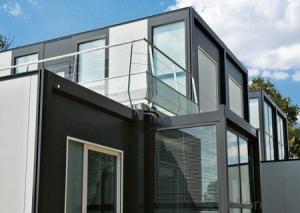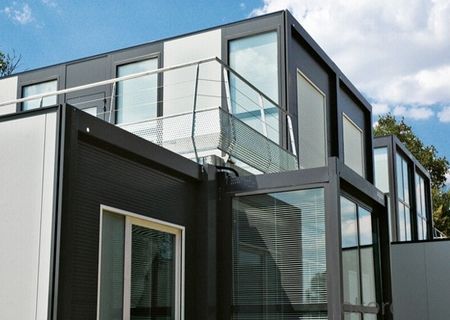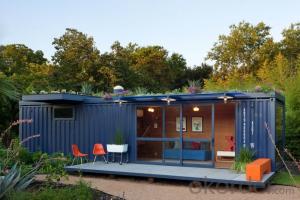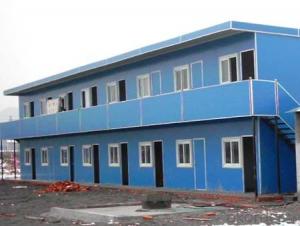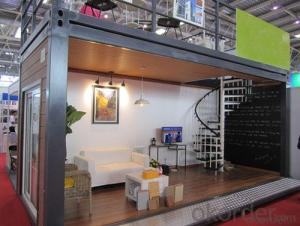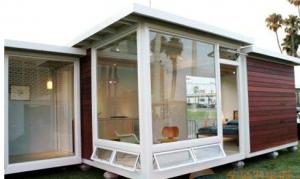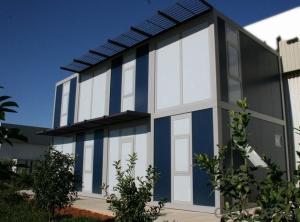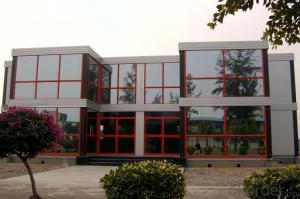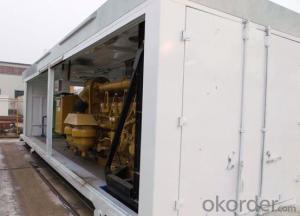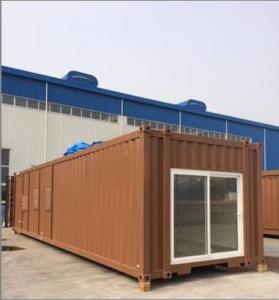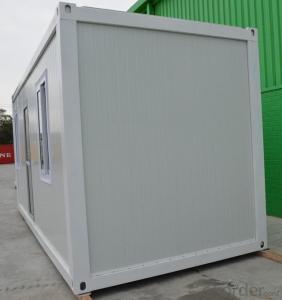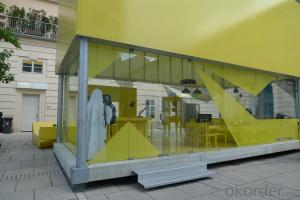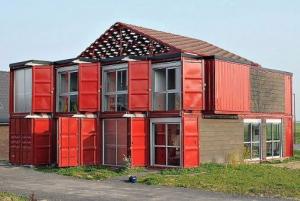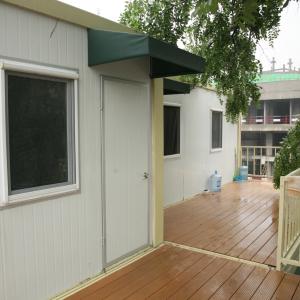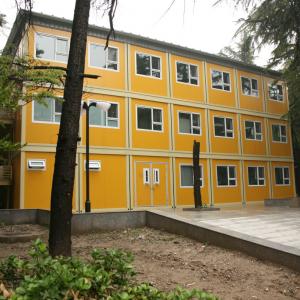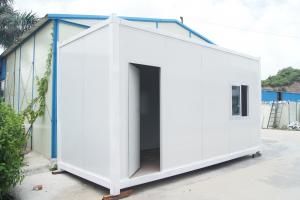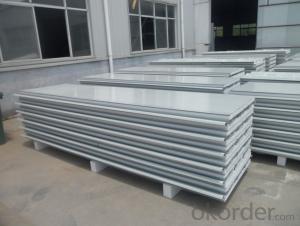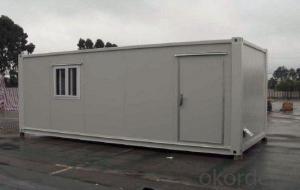container house for building
- Loading Port:
- China Main Port
- Payment Terms:
- TT OR LC
- Min Order Qty:
- -
- Supply Capability:
- -
OKorder Service Pledge
OKorder Financial Service
You Might Also Like
Specifications
Container House
cost-efficient, expandable in each direction, transportable
Container House
1. GENERAL
The standard container for various purposes is suitable for international container transport. It is of appropriate external dimensions and has connections for lifting and fixing or compounding. The container is designed as a light construction consisting of floor and roof frames and corner profiles. The construction enables compounding of individual containers in longitudinal and transverse directions without limits. It also enables compounding of containers in 2 floors in height (ground floor + first floor), or in 3 floors in height for warehousing of these containers (ground floor + 2 floor).
The wainscots of the container are made of light insulation panels and offer pleasant climate in the interior due to their building and physical properties.
Delivery: Containers can be delivered assembled or individually in kits 648 mm high.4 kits can be bundled in packages 2591 mm high (ISO dimensions)
2. DIMENSIONS and TARE (ISO Standard 1161)
-External length 20/(inner length) 20: 6.055m/(5.851m)
-External width/(inner width): 2.435m/(2.231m)
-External height/inner height: 2.790m/(2.510m)
-Tare: 1950 Kgs
3. STEEL FRAMEWORK
3.1 Material: cold formed steel profiles in a thickness of 3 to 4mm (bottom rails).
3.2 Surface working: electric galvanization min 15 μm, zinc compatible epoxy ground coat in a thickness of 30μm , final zinc compatible vinyl acrylic coat in a thickness of 60-70μm.
3.3 Fittings: 8 comer fittings (dimensions according to ISO standard 1161), rainwater pipe in the roof framework, plate thickness of 10mm excluding top corner fittings of the top kit of each bundle (20mm thickness)
3.4 Forklift openings: openings for fork-lift pockets in the floor framework, dim 88×250mm in a distance of 1200mm
4 .FLOOR
4.1 Composition:
-external wainscot: flat galvanized steel sheet metal in a thickness of 0.5mm.
-insulation filling: non combustible mineral wool in a thickness of 100 mm among steel transverse supports. Mineral wool density: 60 Kg/m3
-steam blockade: PE foil in a thickness of 80μm
- plywood panel in a thickness of 18mm
-glued PVC flooring covering in a thickness of 1.5mm.
4.2 Permitted loading : 2.50 KN/m2
4.3 Coefficient of thermal conductivity: l=0.039 W/mK
4.4 R value (Thermal Resistance) = 2.56 m2K/W
4.5 XPS insulation option: it is possible to choose an alternative insulation filling: extruded polystyrene (XPS) in a thickness of 80 mm among steel transverse supports.
XPS density :35 kgs/cubic meter
Coefficient of thermal conductivity: l=0.029 W/mK
R value (Thermal Resistance) = 2.76 m2K/W
5. CEILING:
5.1 Composition:
-external wainscot: flat galvanized and painted steel sheet metal in a thickness of 0.5mm.
-insulation filling: non combustible mineral wool in a thickness of 100mm among plywood purlins. Mineral wool density: 60 Kg/m3
-steam blockade: PE foil in a thickness of 80μm
-inner wainscot: chip wood panel in a thickness of 9 mm with a foil in white color; joining of chip wood panels with PVC profiles
5.2 Meteor water outlet: 4 each of PVC rainwater pipes, diameter 50mm in corner pillars
5.3 Permitted loading: 1.50 KN/m²
5.4 Coefficient of thermal conductivity: l=0.039 W/mK
5.5 R value (Thermal Resistance) = 2.56 m2K/W
6. FACADE WALLS
6.1 Side panels width: 1145mm; total panel thickness: 70mm.
Five panels fit into the long side and two panels fit into the short
side of container and they are fully interchangeable
6.2 Composition:
-External wainscot: galvanized and painted steel sheet metal in a thickness of 0.5mm.
-Insulation filling: non combustible mineral wool in a thickness of 50mm in the wood framework. Mineral wool density: 60 Kg/m3
-Inner wainscot: chip wood panel in a thickness of 9 mm with a foil in wood pattern (bright oak or white).
Joining of panels with PVC profiles. Final elements in the interior are made of chip wood panel in a thickness 8mm with a foil in wood pattern.
6.3 Permitted loading: 1.00 KN/m²
6.4 Coefficient of thermal conductivity: l=0.039 W/mK
6.5 R value (Thermal Resistance) = 1.28 m2K/W
6.6 100 mm insulation option: the framework can be modified so that mineral wool insulation reaches a thickness of 100mm. In this case R value (Thermal Resistance) goes up to: 2.56 m2K/W.
Note that 100 mm thick wall panels are not fully interchangeable like standard 50 mm ones
7. DOORS
Standard external door. Single fold, 40mm thick, made of:
· a frame in prepainted aluminum
· hot galvanized and prepainted steel sheets (inside and outside)
· insulated with PL (polystyrene)
Opening dimensions of 808×2030mm, furnished with a handle lock with 3 keys.
Net opening dimensions: 754 x 1985 mm.
Also 845 x 2000 mm net opening is available.
8. WINDOWS
8.1 Windows
Option 1: made of PVC, white color, with dimensions 800×1100mm, glazed with double layer glass in a thickness of 4/15/4mm, with sliding mechanism (one side fixed and one sliding)
Option 2: made of PVC, white color, with dimensions 800×1100mm, glazed with double layer glass in a thickness of 4/15/4mm, with tilt and swing mechanism
Option 3: made of PVC, white color, with dimensions 800×1200mm, glazed with double layer glass in a thickness of 4/15/4mm, with tilt and swing mechanism
8.2 Rolling shutters
Option 1: external PVC rolling shutters in PVC guides.
Option 2: external Aluminum rolling shutters without insulation in Aluminum guides.
Option 3: external Aluminum rolling shutters with insulation in Aluminum guides.
9. ELECTRICAL INSTALLATIONS
9.1 Standard: according to VDE 100 and CE regulations
9.2 Voltage: 220 V, 60 Hz single phase
9.3 Network connections: CEE-connection plus/socket, 3-pole 32 A, 220V, mounted on the top frame in upper corners of a shorter side wall
9.4 Inner distribution system: BVVB cables of suitable dimensions (6, 2.5, 1.5 mm) ,CE marked , flush-mounted.
All cables (located on the ceiling and inside wall panels) run into CE certified plastic conduits. Roof cables and panel cables are connected with CE compliant jacks. All jack connections are protected inside CE marked and IP44 rated distribution boxes.
9.5 Protection: protective current switch (40/2E-0,03A), automatic fuses (B-characteristics) of suitable power (10A, 16A)
9.6 Earthing: galvanized connector with a steel plate of
dimensions 30x80mm welded on the bottom frame
- Q: Can container houses be built with a garage or carport?
- Yes, container houses can definitely be built with a garage or carport. One of the advantages of using shipping containers for building homes is their modular nature, which allows for easy customization and addition of various structures. Many container house designs include a garage or carport as part of the overall layout. These can be either attached or detached from the main living area, depending on the homeowner's preferences and available space. Building a garage or carport with shipping containers offers several benefits, such as cost-effectiveness, durability, and sustainability, making it a popular choice among container house enthusiasts.
- Q: Are container houses prone to leaks or water damage?
- Container houses are generally not prone to leaks or water damage if they are properly designed and constructed. With proper insulation and sealing, container houses can effectively keep water out. However, it is important to note that like any other type of construction, the quality of materials and workmanship will play a significant role in preventing leaks and water damage. If the container is not properly sealed or if there are structural issues, such as rust or corrosion, it can lead to potential leaks or water infiltration. Regular maintenance and inspections are essential to ensure the integrity of the container house and prevent water-related issues. Additionally, proper drainage and landscaping around the house can help divert water away from the foundation, reducing the risk of water damage. Overall, with careful planning, appropriate construction techniques, and regular maintenance, container houses can be just as resistant to leaks and water damage as traditional houses.
- Q: How big is the container type?
- First, he is easy to transport, especially for the frequent replacement of the construction unit
- Q: Are container houses suitable for religious or spiritual centers?
- Yes, container houses can be suitable for religious or spiritual centers. Container houses offer flexibility in design and can be customized to accommodate the specific needs of religious or spiritual practices. They are cost-effective, eco-friendly, and can be easily transported or relocated, making them ideal for setting up temporary or mobile centers. Additionally, container houses can be modified to create serene and peaceful environments conducive to meditation, prayer, or other religious activities.
- Q: Can container houses be designed with a built-in wine cellar or storage?
- Yes, container houses can definitely be designed with a built-in wine cellar or storage. While container houses are known for their compact and innovative designs, they can be modified to include various amenities, including wine cellars or storage areas. These spaces can be custom-designed to suit the homeowner's needs and preferences, ensuring the proper storage and display of wine bottles. Additionally, container houses offer the advantage of being easily customizable, allowing for the integration of features like temperature control, humidity regulation, and proper insulation to create the ideal environment for storing wine. With the right design and modifications, container houses can accommodate a built-in wine cellar or storage, making them a perfect choice for wine enthusiasts.
- Q: Can container houses be designed with large windows for natural light?
- Certainly, container houses can be designed to incorporate large windows in order to maximize natural light. The versatility and adaptability of shipping containers as building materials allow for various architectural designs to be implemented. By carefully considering the structural aspects and engaging in proper planning, container houses can effectively integrate large windows to ensure ample natural light permeates the living space. The size and placement of windows in a container house greatly depend on the specific design objectives and the intended purpose of the area. Architects and designers possess the capability to strategically position windows, taking into account factors such as insulation, ventilation, and privacy, while maximizing the amount of natural light that enters. To guarantee the structural soundness of the container, it may be necessary to reinforce the surrounding walls where the windows are to be installed. This can be accomplished by incorporating additional steel supports or framing around the openings for the windows. Additionally, it is essential to implement insulation and weatherproofing measures to optimize energy efficiency and comfort within the container house. Container houses that integrate large windows can create a luminous and breezy living environment, fully capitalizing on the benefits of natural light and providing a sense of spaciousness. Furthermore, these windows can offer picturesque views of the surrounding landscape, elevating the overall aesthetic appeal of the container house. In conclusion, container houses can undeniably be designed with large windows to enhance the inflow of natural light, resulting in a well-illuminated and visually pleasing living space. Through meticulous planning and appropriate modifications, container homes can be transformed into welcoming and cozy areas that embrace the advantages of natural lighting.
- Q: Can container houses be easily expanded in the future?
- Indeed, container houses possess the capability of effortless future expansion. The modularity of shipping containers stands as a key advantage when considering them as construction materials. By stacking or connecting containers, it becomes possible to fashion larger living spaces, facilitating simple expansion. Furthermore, containers lend themselves to easy modifications and adjustments to accommodate the unique preferences of homeowners. Whether through the addition of more containers or walls, or the removal of sections, one can readily adapt the size and layout of the dwelling to suit the occupants' needs. Such flexibility renders container houses an optimal choice for individuals who foresee future expansion or alterations in their living situations.
- Q: Are container houses resistant to wildfires or forest fires?
- Container houses can be resistant to wildfires or forest fires, but it depends on several factors. The materials used to build the container house play a crucial role in its resistance. Shipping containers are typically made of steel, which is a non-combustible material and can withstand high temperatures. This makes them more resistant to catching fire or being severely damaged by flames. However, it is important to note that container houses still need to be properly insulated and have fire-resistant features to enhance their resistance to wildfires. These features can include fire-resistant coatings, fireproof insulation materials, and fire-rated windows and doors. Additionally, the surrounding environment and vegetation can also influence the level of fire resistance. If a container house is located in an area with a high risk of wildfires, it is recommended to take additional precautions, such as clearing vegetation around the house and creating a defensible space. Overall, while container houses have the potential to be resistant to wildfires, it is crucial to ensure that proper fire-resistant measures are in place during construction and to take necessary precautions depending on the surrounding fire risk.
- Q: Can container houses be designed with a futuristic or spaceship-inspired look?
- Yes, container houses can definitely be designed with a futuristic or spaceship-inspired look. With the right imagination and design elements, container houses can be transformed into futuristic and visually striking structures that resemble spaceships. The use of sleek, angular lines, metallic finishes, and innovative materials can help create a futuristic aesthetic. Additionally, incorporating large windows, unique shapes, and advanced technologies can further enhance the spaceship-inspired design.
- Q: What is a container house?
- A container house, also known as a shipping container home, is a type of housing structure that is made from repurposed shipping containers. These containers, typically made of steel, are designed to transport goods across long distances using various modes of transportation such as ships, trains, and trucks. However, due to their strength, durability, and availability, they have gained popularity as an alternative building material for constructing homes. Container houses are usually built by stacking and combining multiple containers, creating a larger living space. Depending on the design and desired outcome, containers can be modified and customized in various ways to suit individual preferences. This can include cutting openings for windows and doors, adding insulation for temperature control, installing plumbing and electrical systems, and fitting interior finishes to create a comfortable living environment. The benefits of container houses are numerous. First and foremost, they are an environmentally friendly housing option as they make use of existing resources. By repurposing shipping containers, we reduce waste and prevent them from ending up in landfills. Additionally, container houses are cost-effective compared to traditional construction methods. The use of pre-existing containers significantly reduces the cost of materials and labor, making them an affordable housing solution for many. Moreover, container houses are highly durable and weather-resistant due to their original purpose of withstanding harsh conditions during transportation. They are built to withstand extreme weather events, such as hurricanes and earthquakes, and are designed to last for several decades. Container houses also offer flexibility and versatility. They can be transported to different locations, offering the possibility of a mobile or temporary housing solution. Additionally, container houses can be easily expanded or modified, allowing for future growth or changes in living requirements. Overall, a container house is an innovative and sustainable housing option that combines functionality, affordability, and versatility. It provides a unique and modern living space while also contributing to the reduction of waste and environmental impact.
Send your message to us
container house for building
- Loading Port:
- China Main Port
- Payment Terms:
- TT OR LC
- Min Order Qty:
- -
- Supply Capability:
- -
OKorder Service Pledge
OKorder Financial Service
Similar products
Hot products
Hot Searches
Related keywords
